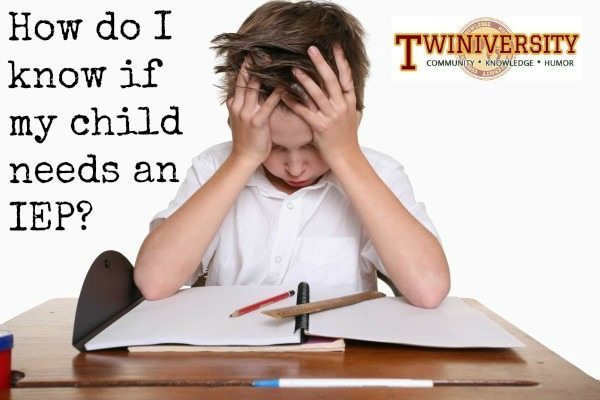Last updated on July 1st, 2024 at 04:58 pm
The Twiniversity “What If…” series features unexpected circumstances in the life of a twin parent and how our Twiniversity members have coped with them. We hope that they might help you feel more prepared if you ever find yourself in the same situation.
As a school administrator, I see students at many different ability and achievement levels. I think we all realize that every student has strengths and weaknesses, and sometimes those manifest themselves in the classroom. One of the toughest things for a parent to watch is when their child is struggling with something in life, particularly in school. What makes it even more difficult is that by the time a student reaches school age, they are naturally compared to other students in their grade level. This comparison among peers will continue throughout their formal schooling career and will even be considered in their college admissions.
Knowing this, there are many reasons why parents can get stressed out regarding school performance. But what do you do when you notice your child is struggling in school? It is possible that a student is just taking longer to get to a certain point in their academics, but it is also possible that they are struggling with a learning disability or other disabling condition that prevents them from accessing the curriculum properly. If you as a parent are concerned that your child may be struggling due to a learning disability, there are steps you can take that will get your child some additional resources.
Public schools provide students that are identified with disabilities an Individualized Educational Plan, or IEP for short. This IEP outlines learning goals for students that are specifically suited to the student’s areas of weakness. However, this is not always needed, so it’s important to know what the steps are for making sure this is the path you need to take.
Step 1: Ask for Input From Teachers

Teachers see your child every day. Don’t be afraid to ask them if your child appears to be on grade level, particularly in math and reading/language arts, or if they require more time to finish assignments and tests. If there is a pattern of struggling in math and/or reading, there is a possibility that a discrepancy exists. While a disability can manifest itself later in life, an IEP can start as early as age three. If there is a problem, feel free to get input from the people that are around your child the most. Even preschool teachers can start to monitor a student’s progress more closely if you ask them.
Step 2: Refer Your Child to the Designated Team at School
Different districts have different names for the teams, but in our district it is referred to as the Instructional Support Team. This team of staff members reviews referrals made to the school and makes decisions based on whether a student qualifies for Exceptional Children’s services. A parent or a teacher can make a student referral. This team will also attempt to collect data on your student as they implement interventions (tutoring, small group instruction, etc.). If the interventions make a difference, they may not proceed with moving towards an IEP.
Step 3: Getting Testing
If the team decides after interventions that your child would still qualify for an IEP, they will request your permission to start testing. The testing will involve things like a vision/hearing screening, educational and psychological evaluation, and social history. If a medical diagnosis is required (like for ADHD), that information will also be necessary to make a determination. Most districts have school psychologists that can evaluate students and interpret the data for you. You can also have your child tested from outside agencies and bring the report so that the psychologist can analyze it. They are always looking for discrepancies between a child’s ability and achievement, and some of the assessments they will do will be timed, while others will not be timed. It’s all a part of analyzing processing speed, what you child is capable of, and what their educational output actually is.
Step 4: IEP Team Will Meet With You

After the testing has been conducted and analyzed by the psychologist, they will meet with you as well as a regular education teacher, a special education teacher who is designated as the case manager, and an administrator. They will go over the results with you and determine whether to proceed with the IEP process. If they decide that your child qualifies, they will make goals that are based on your student’s areas of weakness and will place your student appropriately. In elementary school, this may mean getting pulled out of the regular education classroom for small group instruction for a percentage of the day. In middle school, where I am, it typically involves moving to an inclusion class (regular education classroom with two teachers) or a resource class (smaller group, one teacher, teaches curriculum at a slightly slower pace). In some cases, depending on the disability, it could even mean a move to a self-contained classroom with one teacher that teaches all the subjects.
Step 5: Sign and Monitor
Once you sign the documents, the IEP goes into effect and your child will begin receiving services. At any time, the parent can request an IEP meeting to discuss changes to the IEP or to look at exiting their student from services altogether. Just remember that once you decide to exit, you have to go through the entire process again if you want to start it back up. The school will meet with you once a year to do what’s called an annual review to update goals for a new grade level. About every three years, a student is up for re-evaluation, however, the team can decide that testing is not needed to continue services, but that’s a decision for you as a parent to make. IEP’s are also federal documents, so even if you move to a different state, they honor the IEP as written and may re-evaluate your child as different states have slightly different standards in regards to classifications of disabilities.
Hopefully you have found this helpful in knowing what needs to happen if you think your child might need an IEP. However, the earlier these things are noticed by teachers and parents, the more help can be given to allow students to exit the process later on in their schooling. If you need more information about the subject, please refer to IDEA (Individuals with Disabilities in Education Act) legislation as to exactly what areas are covered.

Mike Crider is a school administrator and father of twin toddler girls. He is the author of the blog “The Father of Twins” and the e-book “Twin Dad Talks: Help for First-Time Fathers Navigating Pregnancy”. You can follow him on Pinterest.







